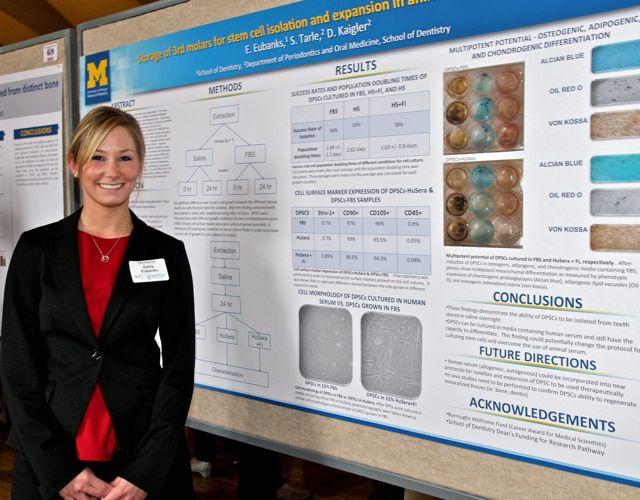Using Wisdom Tooth Stem Cells to Regenerate Dental Tissues?2 min read
Ann Arbor, MI — February 28, 2013 — Imagine going to a dental office to have a wisdom tooth extracted. After the tooth is removed, the dentist then sends the tooth to a laboratory where the stem cells inside the dental pulp of the tooth are collected and stored for possible use later. Instead of replacing the wisdom tooth with an implant or other prostheses, the patient’s own stem cells, for example, might then be used to re-grow another tooth.

Futuristic? Perhaps. But second-year dental student Emily Eubanks is investigating if that possibility might one day become a reality. Eubanks won the Grand Prize during the School of Dentistry’s annual Research Day.
“I was interested in discovering a clinically feasible way to store wisdom teeth after extraction, so that at some point in the future we could extract the stem cells from the dental pulp to use them for our research,” she said. “I was also interested in discovering a way to grow these cells, other than the traditional method used in research using animal serum, since that method poses a risk when used in humans.”
Possible Benefits
Mentored by Dr. Darnell Kaigler, an assistant professor of dentistry in the Department of Periodontics and Oral Medicine, Eubanks discovered that saline was a good storage solution and that storing the teeth this way for 24 hours did not have any significant impact on stem cell collection. She then looked at using human serum as a way to grow the cells, instead of animal serum.
“Discovering that these teeth can be stored in saline for 24 hours was important since it will allow dentists time to take extracted wisdom teeth and send them to a laboratory to have stem cells isolated,” she said. “The traditional method for isolating similar types of stem cells involves collecting them from bone marrow in the hip, which can be painful and invasive.”
Since wisdom tooth extraction is a routine procedure, being able to use wisdom teeth stem cells offers dentists and their patients new possibilities. “If a patient has pulpitis or a carious lesion, instead of using metal, ceramic or other restorative materials, we could potentially use these stem cells to help regenerate the diseased or damaged tissue to restore the tooth,” she said.
